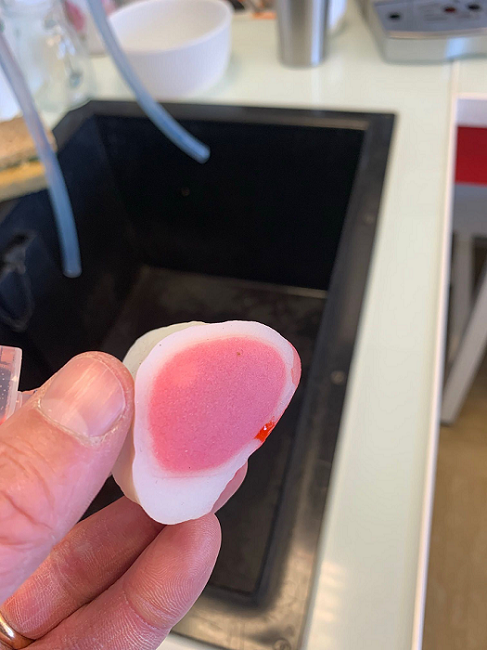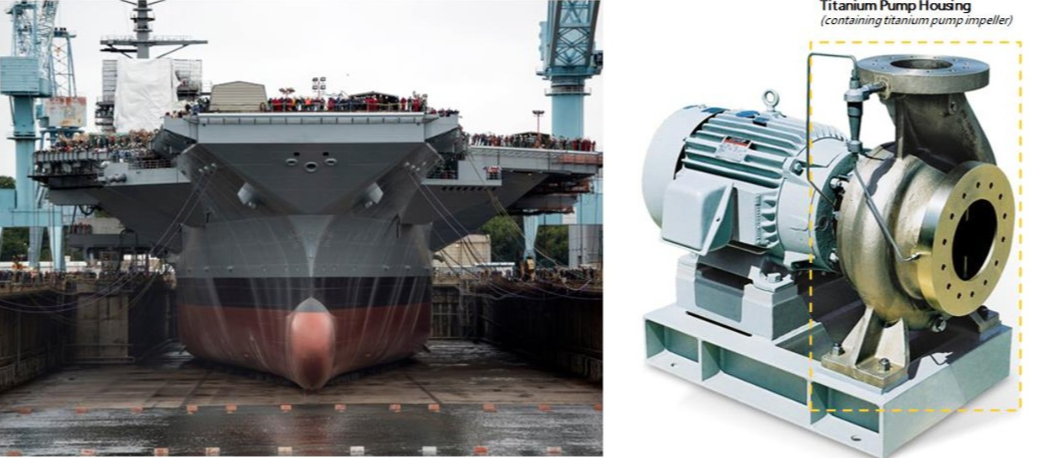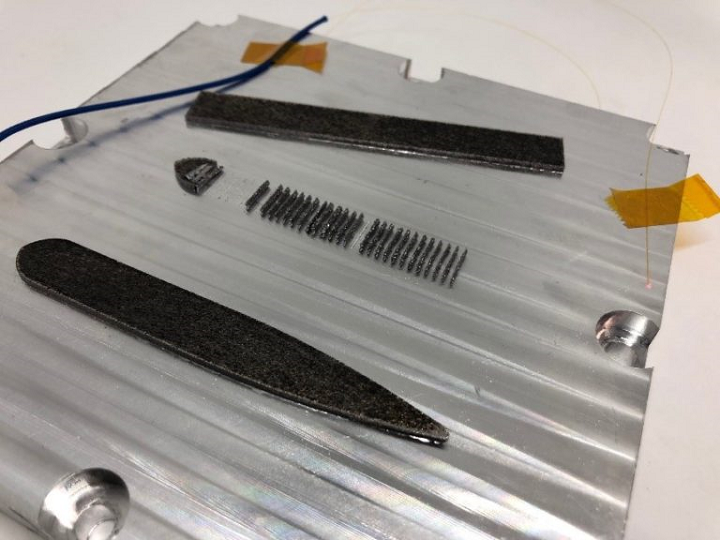Fabrisonic is introducing a new build plate with embedded sensors; this hardware news kicks off today’s 3D Printing News Briefs. Moving on, we’ll cover some of the major 3D printing applications, starting with medical, as CHU de Brest is using Stratasys technology to print patient-specific anatomic models. Moving on to military, IperionX is partnering with Carver to print titanium pump components for the US Navy, and in aerospace, Launcher’s newest space platform features many 3D printed parts. Finally, the world’s first 3D printed horse trailers are here.
Fabrisonic’s New SmartPlate with Embedded Sensors
Fabrisonic was asked by collaborator EWI how loads could be measured going through the build plate during 3D printing, and decided to come up with an answer. Collaborating with EWI and Luna Innovations, the company used its ultrasonic additive manufacturing (UAM) technology to print a PBF build plate with embedded optical strain gauges and thermal sensors. Called the SmartPlate, this new innovation can be made to fit custom specifications, and is able to extract data from its sensors for real-time printing, or post-processing, analysis. It’s helpful for customers dealing with parts that delaminate or debond during printing, and are curious to see how stress accumulates during a build in real time, as well as evaluate the risk of a single part that’s a portion of a larger structure, learn how to reduce waste through early failure detection, and more. The SmartPlate was tested out in EWI’s PBF system on a build with “highly problematic features,” and was able to pick up lots of extra data during the print, such as the fact that defects appeared as large compressive strains which formed early on at localized points.
“Fabrisonic starts with a billet build plate and mills channels in locations where sensors are to be embedded. Sensors are placed in the milled cavities, and Ultrasonic Additive Manufacturing is used to print solid metal over the sensor. The low-temperature process does not harm the sensors; thus, the metal has continuous, contiguous, and direct contact with these sensors. When the product is completed, the customer has a fully consolidated metal plate with integral sensors buried within it.”
CHU de Brest 3D Printing Anatomic Models with Stratasys Tech

The J5 MediJet’s multi-material multi-color 3D printing capability enables the production of ultra-realistic models for pre-surgery preparation and training
The Regional University Hospital of Brest (CHU de Brest) in France is seeing major pre-surgical planning improvements after working with Stratasys partner-reseller Cylaos to install the J5 MediJet 3D printer. Its multimaterial and multicolor capabilities are enabling more realistic, patient-specific anatomic models for planning and training purposes, and improving patient outcomes. The installation occurred with support from the hospital’s Innoveo Endowment Fund, which is designed to support projects that improve patient care, quality of life and comfort. Previously, some models were out-sourced to external providers for manufacturing, but the level of quality just wasn’t there, and the hospital also had a growing need to better manage increasing volumes, which is why the decision was made to acquire an in-house J5 MediJet. Since the installation, use of the printer has expanded to multiple departments, such as orthopedic and vascular surgery, neurosurgery and biomedical service, and interventional neuroradiology.
Samuel Guigo, radiology and 3D printing technician at the CHU, said, “The accuracy we now enjoy with the J5 3D printed models means our surgeons are far better equipped and prepared before going into theater, which significantly and quantifiably reduces surgical-related risks through improved safety.
“When preparing a vascular surgery for example, millimetric precision is mandatory. With the J5 MediJet, not only can we achieve this, but we have the flexibility to re-print the models to iterate and achieve optimal results, reproducing them with complete consistency, as required. We were simply unable to do this previously.”
IperionX Partnering with Carver to 3D Print Components for US Navy

Figure 1: USS Gerald R Ford in dry dock in Newport News, VA & Carver Pump M-Series ASTM F998 Close-Coupled Centrifugal Pump
The U.S. doesn’t have the domestic capacity to manufacture the large titanium castings that are needed for high-performance centrifugal pumps, which has resulted in long lead times for new components that are sourced from a problematic foreign supply chain. But the US Navy’s Naval Sea Systems Command (NAVSEA) has developed additive manufacturing processes for over 500 approved parts in US submarines and ships, and the US Navy is speeding up its efforts to scale the technology. IperionX is happy to announce that it’s partnering with Carver Pump to produce 3D printed titanium pump components for the US Navy. With its lower carbon, lower cost, high-quality titanium powders made in this country from 100% recycled titanium feedstocks, IperionX is able to print these specialized pump components, which gives the US Navy the ability to increase equipment availability, lower lead times for critical parts, and sustainably reshore an important U.S. titanium metal supply chain. Carver, which has pumps installed on all current Navy ship building programs, will design the pump components and lead the qualification process, and guide IperionX on the prototyping.
“We are delighted to be working with IperionX to help introduce domestic sourced, 100% recycled titanium into the US Navy’s supply chain,” said Andrew Carver, Carver’s CEO. “When coupled with benefits of Additive Manufacturing, the partnership provides a significant potential to benefit to Navy operations through the rapid production of complex, operation critical titanium parts, providing a potential reduction in lead times and increasing equipment availability. We see this partnership as the first step in a larger relationship focused on both Navy surface ships as well as new parts for other marine applications.”
Launcher’s Orbiter Platform Features 3D Printed Parts

Orbiter, developed by Launcher, is a satellite vehicle and platform that delivers cube and small satellites to space directly, and/or hosts rideshare payloads, cost effectively. A multitude of 3D printed parts, from several metal alloys, are used in this spacecraft. All parts shown in the graphic were manufactured using Velo3D’s fully integrated metal additive manufacturing solution. Orbiter made its debut on SpaceX’s Transporter-6 rideshare mission in January of 2023.
California-based small launch vehicle manufacturer Launcher, which was just acquired by Vast, is revealing more of the 3D printed parts that make up Orbiter, its orbit transfer vehicle (OTV) platform program. With a payload capacity of up to 400 kg, the OTV debuted last month on SpaceX’s Transporter-6 rideshare mission. Orbiter integrates with every Cube and small satellite separation system, and has a propulsive capability of 500 m/s delta-V, which, according to Launcher’s website, will increase the “capability of major rideshare missions,” and ensure more accurate placement of spacecraft in their exact orbit.
Orbiter is the top end of the Launcher Light rocket’s three-stage design, and all of the parts in the above graphic were 3D printed using Velo3D’s fully integrated metal AM solution. We already knew that the engine’s shrouded impeller was 3D printed, and the graphic shows several other 3D printed important components, such as the engine chambers and injectors, both printed out of Inconel 718. The OTV’s thruster bracket and manifold, along with the star camera baffle for precise navigation, were printed using Aluminum F357. Finally, the platform’s thrust structure, spring housings, and multi-purpose tanks were printed in a titanium alloy.
World’s First 3D Printed Horse Trailer
Finally, Double D Horse Trailers is partnering with Loci Robotics Inc. and One One Lab to create the world’s first 3D printed horse trailers. The automotive design studio created the modernized, functional design, while LOCI is working to make the trailer “a safe and efficiently printable product” with its LOCI-Two+ system robotic arm system. There are several reasons Double D Horse Trailers and its partners wanted to go with 3D printing rather than traditional manufacturing to mass manufacture the trailers, including the reduction of supply chain limitations and ability to use recycled materials—the 3D printed trailers will be made mostly of polycarbonate, with, as One One Lab says, carbon fiber reinforcement. This leads to another reason: PC has been shown in studies to have high temperature resistance, which makes the material more durable. This is an important feature when you’re transporting big, strong animals like horses!
Subscribe to Our Email Newsletter
Stay up-to-date on all the latest news from the 3D printing industry and receive information and offers from third party vendors.
You May Also Like
Gorilla Sports GE’s First 3D Printed Titanium Cast
How do you help a gorilla with a broken arm? Sounds like the start of a bad joke a zookeeper might tell, but it’s an actual dilemma recently faced by...
Nylon 3D Printed Parts Made More Functional with Coatings & Colors
Parts 3D printed from polyamide (PA, Nylon) 12 using powder bed fusion (PBF) are a mainstay in the additive manufacturing (AM) industry. While post-finishing processes have improved the porosity of...
$25M to Back Sintavia’s Largest Expansion of Metal 3D Printing Capacity Since 2019
Sintavia, the digital manufacturing company specializing in mission-critical parts for strategic sectors, announced a $25 million investment to increase its production capacity, the largest expansion to its operations since 2019....
Velo3D Initiates Public Offering in a Bid to Strengthen Financial Foundations and Drive Future Growth
Velo3D (NYSE: VLD) has been among a number of publicly traded 3D printing firms that have attempted to weather the current macroeconomic climate. After posting a challenging financial report for 2023,...

































